The escavation of the highway tunnel and of the LNGS under the Gran Sasso mountain has given an opportunity to install, far down from the surface, an interferometer able to perform high sensitivity continuous measurements of crustal deformation. The interferometric station has been planned to measure relative displacements of three end points located at the vertices of a right-angled isosceles triangle (A, B, C in Figure 1).
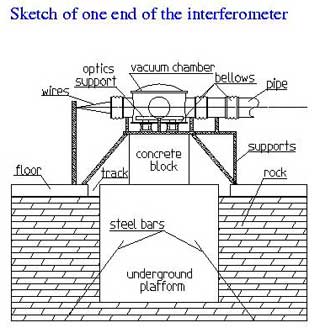
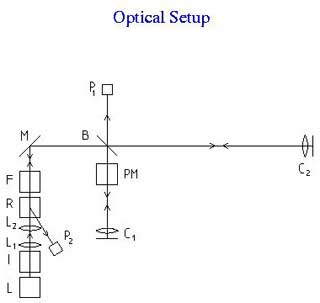
An interferometer measures the difference in extension between two baselines.
From May 1994 to October 1995 we have monitored the extension of a 90-m long baseline (azimuth = N66E) approximately perpendicular to the Apennines, using a 20-cm long reference baseline (azimuth = N24W). Because laser frequency fluctuations can give spurious signals whose amplitude depends on the difference in length between the two baselines, from December 1995 to September 1998 both of them were 90-m long and one component of shear strain was measured. The two baselines are now monitored independently. We use a sigle laser source so that the difference between the two signals is independent of laser fluctuations.
Sampling rate was variable till 31 January 1996, fixed to 0.5 Hz till September 1998 and now is fixed to 5 Hz.
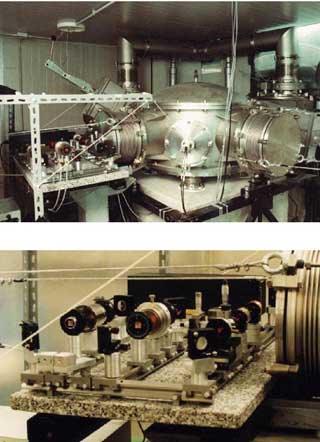
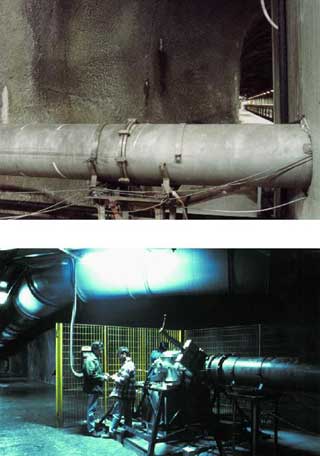
The nominal sensitivity of our interferometer is about 3 x 10-12 strain units and its response time is of the order of milliseconds. During the transit of teleseismic waves it recorded signals as large as 6 x 10-7 and as fast as 10-7 s-1 without any nonlinearity or abnormal behavior. The actual sensitivity of the interferometer is limited by the noise level of the site, whose power spectral density approximately follows the usual 1/f2 law.
Recorded signals include earth tides, teleseismic waves, and slow earthquakes
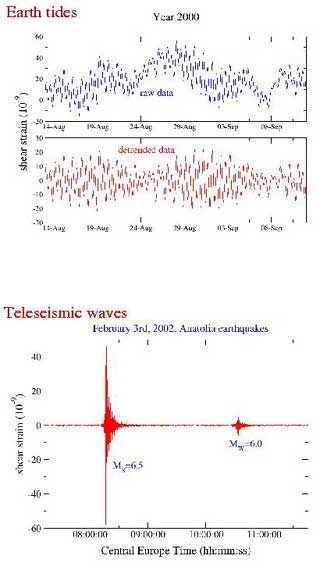
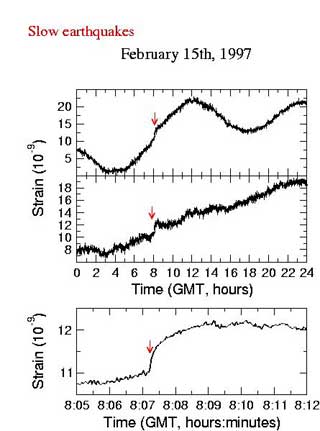
Geodetic instrumentation at the Interferometric Station also comprises a high-sensitivity tiltmeter, made by CNR-IFSI. A very-broad band seismometer (360 s) has been recently installed by INGV - Centro Nazionale Terremoti
The main scientific result obtained until now consists in the observation and interpretation of more than 180 slow earthquakes during few months after March 1997.
Only very few slow earthquakes had been previously observed in Japan and California as nearly exponential strain changes with durations ranging from about one hour to 3 days and strain steps larger than a few 10-8.
The large number of slow signals recorded by the Gran Sasso interferometer might be surprising, but they are small and the lack of similar observations reported in the literature could be due to much lower sampling rates, to higher noise levels, and to the irregular worldwide distribution of the slow earthquakes and of the few instruments able to detect so small signals. The amplitude of the strain steps and thus the seismic moment scales with the square root of rise time. This scaling law contrasts with the conservative assumption of constant rupture velocity in fault modelling while being consistent with the occurrence of a slow rupture propagation mathematically analogous to heat diffusion in a slab. Such a kind of rupture propagation can occur if the fault dynamic friction is velocity-strengthening. These observations put tight constraints on slow earthquake dynamics and more generally on fault mechanics.
In the same period of occurrence of the slow earthquakes, after more than one year of only background diffused seismicity, a few relevant ordinary seismic swarms were recorded in central Italy. Space-time distributions of the slow earthquakes and of the ordinary seismic swarms and the lack of any cause-and-effect relation suggest that they may be the consequence of a single stress redistribution phenomenon affecting a large area of the Apennines.
Modeling of the observations has lead to identify a very plausible source of the slow events in a local fault, with no historic seismic behaviour. While slow earthquakes occurring in subduction zones, and at the transition between locked and stably sliding segments of the San Andreas fault, are often associated with seismic events, in the case of the Apennines there is no correlation between local seismicity and slow earthquakes. Slow earthquakes, therefore, may also represent a specific failure behavior for a seismically locked fault, adding further complexity to the interpretation of geologic data for seismic hazard estimates.
The project is financed by INFN and INGV (Istituto Nazionale di Geofisica e Vulcanologia).